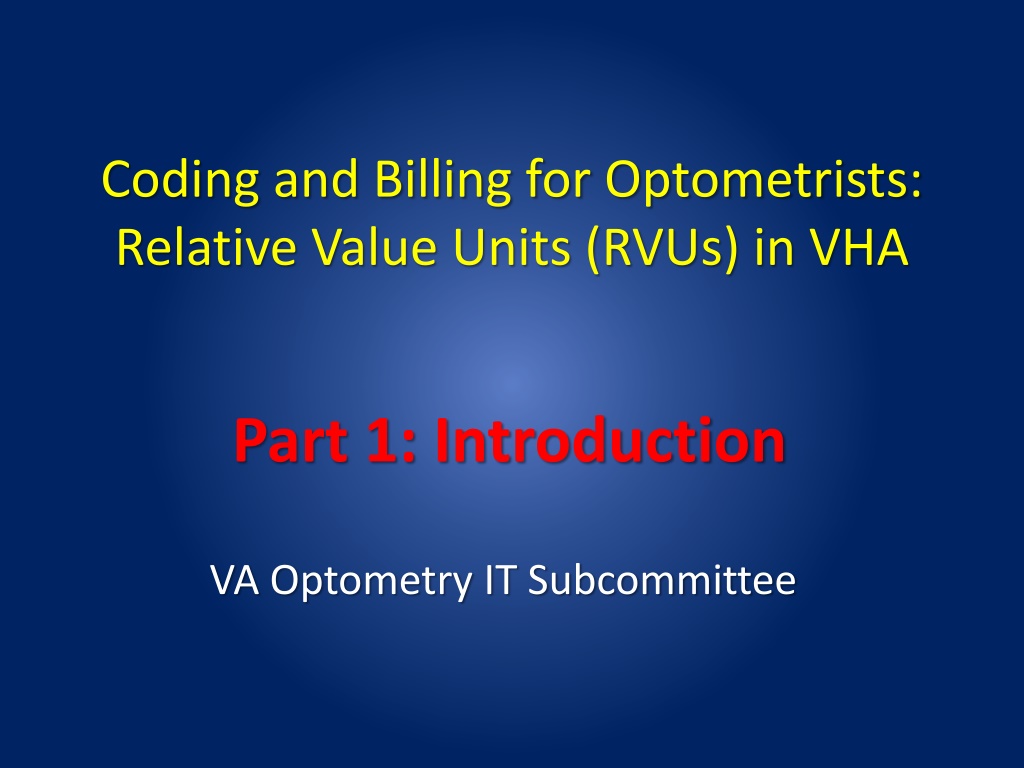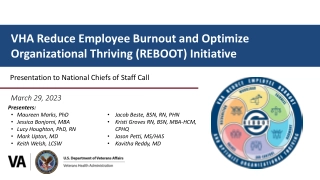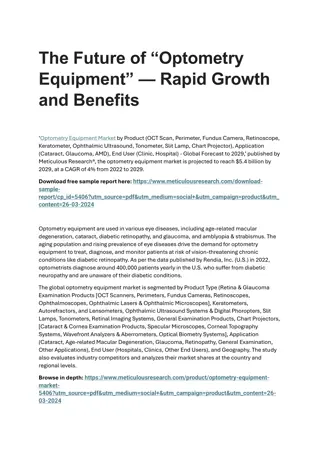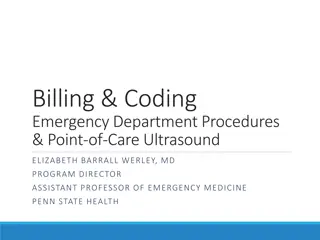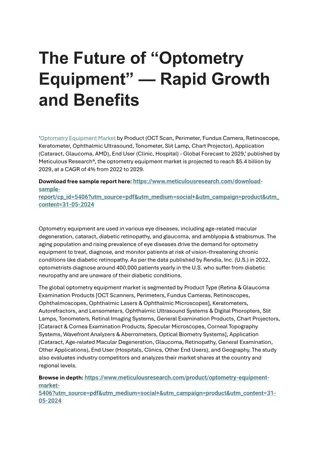Understanding Optometry RVUs in VHA: A Comprehensive Overview
This informational guide delves into the world of Relative Value Units (RVUs) in optometry coding and billing within the Veterans Health Administration (VHA). Learn about RVU-based productivity measurement, the importance of proper coding practices, and the impact on resource allocation. Discover the background, systems involved, and the significance of accurate documentation for optometrists in VHA. Stay informed about the evolving landscape and your role in ensuring precise patient care documentation.
Download Presentation

Please find below an Image/Link to download the presentation.
The content on the website is provided AS IS for your information and personal use only. It may not be sold, licensed, or shared on other websites without obtaining consent from the author. Download presentation by click this link. If you encounter any issues during the download, it is possible that the publisher has removed the file from their server.
E N D
Presentation Transcript
Coding and Billing for Optometrists: Relative Value Units (RVUs) in VHA Part 1: Introduction VA Optometry IT Subcommittee
Authors Ballinger, Rex OD- Baltimore, MD Cordes, Matthew OD- The Villages, FL Fuhr, Patti OD, PHD- Salisbury, NC Ihrig, Carolyn OD- Buffalo, NY Katzenberger, Ann OD- American Lake, WA Kawasaki, Brian OD- Las Vegas, NV Lazarou, Zoe OD- Baltimore, MD Ryan, Raymond OD- Eureka, CA Whitesell, Bethany- Fayetteville, AR Zimbalist, Richard OD- Columbia, MO
Part 1: Introduction Objectives: Background overview of VHA coding & workload accounting methods and how they are now implemented Overview of what will be covered in each of the subsequent modules Overview of the Person Class mapping and RVU systems Importance of proper ICD-9, CPT, and ICD-10 coding
Background Over the past several years, VHA has reviewed physician productivity with a focus on specialty care. Methodologies used in determining productivity have been refined and now include specific data subsets. A Relative Value Unit (RVU) based method has been adopted to measure physician productivity somewhat similar to that used in the private sector and Centers for Medicare & Medicaid Services (CMS) As of FY 2012, Chiropractors, Optometrists, Podiatrists, and Psychologists are now included in this system.
Background Optometry is now under: DSS (Decision Support System) (do not confuse with clinical decision support systems) RVU (Relative Value Unit) System (VA specific) These systems are a costs accounting and clinical activity relational database system. All patient services will need to be correctly and accurately documented to ensure proper resource allocation and utilization. Resources include labor, equipment, support and other expenses.
Background All optometrist outpatient and inpatient PCE (Patient Care Encounter) workload with CPT coding is used in calculating physician productivity within VHA. However, this applies to paid clinicians only. Productivity is expressed in Relative Value Units (RVUs) per physician provider FTEE that is dedicated to clinical duties.
The Winds of Change Due to the significant changes occurring within VHA and eye care, a series of training modules have been developed to facilitate your understanding of what is transpiring, and what your role is in insuring correct documentation of your patient care encounter. This will translate into better allocation of resources for your clinics.
Training Series Overview The following modules will outline the details clinicians will need to understand to meet VHA goals: 1. Introduction- Overview of what changes are occurring 2. DSS, Labor Mapping and RVUs- Keeping it all together 3. ICD-9 Coding- The present 4. CPT Coding- The key to RVUs 5. Examples of Coding and FAQs 6. ICD-10 Coding- It s in the details.
Importance of Coding Inaccurate E/M coding can have the following negative results: Reduced revenues Lost charges on procedures Risk of audit or review Incomplete/inaccurate physician profile Possible fraud charges
Coding Importance VHA facilities must ensure that all encounters in outpatient settings, inpatient appointments in outpatient clinics and inpatient professional services are identified, coded, completed and reside in the Patient Care Encounter (PCE) package. Reasons for not billable encounters are also being monitored (VHA Directive 1600 dated 12/13/13). http://vaww.va.gov/vhapublications/ViewPublication.asp?pub_ID=2962
Why Coding is so Important!! Utilized for Relative Value Units (RVUs): Reimbursement Detect fraud & abuse Study costs Set budgets Assess medical outcomes Compare trends Formulate policy Managed care physician profiling
Understand that YOU CAN T BILL FOR WHAT YOU DO YOU CAN ONLY BILL FOR WHAT IS DOCUMENTED. YOU CAN T GET CREDIT FOR YOUR WORKLOAD UNLESS YOU CODE CORRECTLY. BOTH BILLABLE AND UNBILLABLE WORK IS BEING MONITORED BY VHA.
General Record Rules Doctor is responsible for having good medical records. Doctor should review all records before they are filed. All doctors and staff need to recognize what constitutes good medical records and bad ones. All doctors must code for the diagnosis and procedures they perform.
General Record Rules If it is not recorded, it was not done. If it is not legible, it was not recorded/not done. Abnormal is not sufficient documentation for ordering additional tests. Normal , WNL , Neg... are sufficient to indicate no problems were detected with an organ or organ system.
General Record Rules Every record must include the date and legible identity of the observer. Doctor s electronic signature and printed name will safely cover all payers requirements and workload credit. Initials are OK within a chart, to indicate a doctor or staff person has reviewed a section of the record or has made changes or additions to the record. Keep list of initials and abbreviations to clarify office procedures and reduce audit problems. WARNING: Standard medical abbreviations; MUST follow VA rules on documentation not ophthalmologic rules in your EMR impression!! e.g. PVD is a standard medical acronym for peripheral vascular disease, NOT posterior vitreous detachment!! -ref: Jablonski s Dictionary of Medical Acronyms & Abbreviations- 6th Ed. 2009 Or CPRS->tools->online references-> unapproved abbreviations This will be especially evident on ICD-10 coding.
Decision Support System (DSS) DSS Identifiers (IDs) AKA Stop Codes are the single and critical designation by which VHA defines clinical work units for costing purposes.
Decision Support System Workload Capture Issue Impact Lower provider productivity reported if no encounter is entered/closed out. VAMC will not receive credit for the workload. Product unit costs will increase if workload was under reported. Encounters are completed incorrectly. Be sure each and every clinic is set up correctly and monitor regularly !
DSS, Labor Mapping and RVUs: Keeping it all Together DSS has been in place for some time. Last year, Optometry reviewed/refined the labor mapping and taxonomy codes used nationally. It is imperative that you review your local taxonomy now(if you haven t already done so) to be sure that the correct capture of data is made. This data is used in RVU productivity calculations. (see Person Class Tool in Related Links section at: http://opes.vssc.med.va.gov/Pages/PracticeManagement.aspx)
VA Relative Value Unit A Relative Value Unit (RVU) based method has been adopted to measure physician productivity similar to that used in the private sector and Centers for Medicare & Medicaid Services (CMS). Beginning in FY 2012, Optometry and other specialties have been added within the physician productivity data.
Productivity Measures: Now Underway FY 13 Productivity Measure for All Facilities and VA Provider Type = VA Filtered for Specialties with FY14 Q2 Standards Deliverable Date: Allergy, Chiropracty, Endo, Heme/Onc, Infectious Disease, Nephrology, Neurological Surgery, OB/Gyn, Optometry, Otolaryngology, Pain Medicine, Plastic Surgery, Podiatry, Rheumatology, Thoracic Surgery, Vascular Surgery Requires Annual Review Quadrant Practice Management Reports: Facility Productivity between the MCG 25-75th percentile (Note: 1a,b,c facilities compared against combined 1-High Complexity Benchmark) Requires Program Review: Facility Productivity below the MCG 25th percentile or above the 75th percentile (Note: 1a,b,c facilities compared against combined 1-High Complexity Benchmark) Requires Program Review and Mandatory Report to VISN: Facility Productivity below [Mean - 1 Standard Deviation] (Note: 1a,b,c facilities compared against combined 1-High Complexity Benchmark) *Benchmark Group Notes: -Allergy, OB/GYN, Plastic Surg, Neuro Surg, Vasc Surg use National (VHA) Statistics (criteria based on < 100 MD FTE(C) AND <4 facilities in MCG 2 or 3) -For all other specialties: High Complexity Facilities use High MCG Combined Statistics; Medium Facilities use 2-Medium Statistics, and Low Facilities use 3-Low Statistics
Tiered Productivity Standards Annual Review Quadrant Report & Practice Management Report Productivity Standards: RVU Productivity between 25-75th percentile 2 -Medium Complexity 3,910 - 5,370 Deliverable Date FY14 Q2 Aggregate Specialty Optometry 1-High Complexity (1a-1c) 3,261 - 4,813 Requires Program Review Local Actions Required: RVU Productivity >75th percentile 3 -Low Complexity 3,372 - 4,834 2 -Medium Complexity >5,370 Deliverable Date FY14 Q2 Aggregate Specialty Optometry 1-High Complexity (1a-1c) >4,813 Requires Program Review 3 -Low Complexity >4,834 Local Actions Required: RVU Productivity > [Mean - 1SD] and < 25th Percentile 2 -Medium Complexity 2,056 - 3,910 Deliverable Date FY14 Q2 Aggregate Specialty Optometry 1-High Complexity (1a-1c) 2,979 - 3,261 3 -Low Complexity 3,043 - 3,372 Requires Program Review and Mandatory Report to VISN Mandatory Response: RVU Productivity < [Mean - 1SD] 2 -Medium Complexity < 2,056 Deliverable Date FY14 Q2 Aggregate Specialty Optometry 1-High Complexity (1a-1c) < 2,979 3 -Low Complexity < 3,043 *< 100 MD FTE(C) AND <4 facilities in MCG 2 or 3 Use National Statistics (Note: If no level 3 facilities keep MCG High & Medium Statistics if 4 or more facilities in MCG groupings)
Background Data is derived from: National files in Austin DSS and other data Inpatient and Outpatient encounter data from the Patient Care Encounter (PCE) from CPRS Keep in mind this is relative to direct clinical care; administration, teaching, and research is excluded Additionally, RVU is relative to time actually worked.
Relative Value Units The RVUs for each provider are calculated using work RVUs only. CMS (Center for Medicare and Medicaid Services) also uses malpractice and practice overhead RVU components, but these are NOT used in VHA.
Relative Value Units Details of RVUs will be covered in the next training session to give you a better understanding of how they are derived, and what the data means.
Documentation Guidelines Records should be maintained in a clear, accurate, and legible manner and should support that the service billed: Was actually rendered; Was performed at the level of service reported; And was medically necessary for the patient s condition.
General Principles of Documentation Rationale for all tests ordered should be documented or easily inferred. Past and present diagnoses should be readily available. Appropriate health risk factors should be identified. Patient s progress, response to changes in treatment, and revision in plan should be documented.
General Principles of Documentation The level of E/M service reported on the claim form should be supported by the medical record documentation. The diagnostic code(s) and procedure codes should justify the services provided and be supported by the documentation in the record. (Medical Necessity)
ICD-9 Coding This will be reviewed in a separate module to facilitate current coding requirements. Most are familiar with the current coding, but a review may be helpful for more accurate documentation.
Clinical Coding Overview Reference to ICD-9, ICD-10 codes Reference to CPT codes- the key to RVUs ICD-9 codes are still used presently, and will be reviewed in detail for proper documentation. Reference to SNOMED- CT structure- recently installed ICD-10 coding will be reviewed in detail later in this training Series. Understand ICD-10 codes will be implemented as of October 1, 2014!!
Correct Coding is Dependent Upon Correct identification of evaluation and management principles (E/M) Correct documentation to support level of coding Medical decision making: the level of complexity of making a diagnosis and/or selecting management options # DX/MGT options: The number of diagnostic and/or management options that must be considered.
Correct Coding is Dependent Upon Data: The amount and/or complexity of the medical records, diagnostic tests obtained, reviewed and analyzed. Risk: Significant complications, morbidity, diagnostic procedures and/or management options.
CPT Codes This is the key to developing the correct RVU data. Be sure you carefully document all your CPT codes. We will cover all of the pertinent CPT code information for you in the CPT training module.
CPT (Procedure) Code Categories 92000 Ophthalmology Codes 99000 Evaluation and Management Codes 60000 Surgical Codes 70000 Radiological Codes 80000 Laboratory Codes Details of what is to be used will be reviewed in the CPT coding module.
ICD-10 Codes Coming Down the Pike October 1, 2014 !!!! We will review important medical coding & billing rules that govern ICD-10-PCS in another separate module: Review of the Chapters of ICD-10-CM and what is contained in them What should be done now in preparation for the change How to determine the correct Root Operation selection Find out why specificity matters for ICD-10-PCS Define each character s unique meaning Familiarize yourself with the 7 Character Structure of ICD-10-PCS Review the required documentation to determine the correct code Get the latest on medical coding conventions in ICD-10-PCS Review ICD-10-PCS examples Utilize the qualifier when necessary
Soooo. Stay tuned.. This affects us all!
